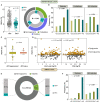Prevalence and Clinical Profiling of Dysglycemia and HIV Infection in Persons With Pulmonary Tuberculosis in Brazil
- PMID: 35127760
- PMCID: PMC8814308
- DOI: 10.3389/fmed.2021.804173
Prevalence and Clinical Profiling of Dysglycemia and HIV Infection in Persons With Pulmonary Tuberculosis in Brazil
Abstract
Background: There are scarce data on the prevalence and disease presentation of HIV in patients with tuberculosis (TB) and dysglycemia (diabetes [DM] and prediabetes [PDM]), especially in TB-endemic countries.
Methods: We assessed the baseline epidemiological and clinical characteristics of patients with culture-confirmed pulmonary TB, enrolled in a multicenter prospective cohort in Brazil (RePORT-Brazil) during 2015-2019. Dysglycemia was defined by elevated glycated hemoglobin and stratified as PDM or DM. Additionally, we used data from TB cases obtained through the Brazilian National Notifiable Diseases Information System (SINAN), during 2015-2019. In SINAN, diagnosis of diabetes was based on self-report. Logistic regression models were performed to test independent associations between HIV, dysglycemia status, and other baseline characteristics in both cohorts.
Results: In the RePORT-Brazil cohort, the prevalence of DM and of PDM was 23.7 and 37.8%, respectively. Furthermore, the prevalence of HIV was 21.4% in the group of persons with TB-dysglycemia and 20.5% in that of patients with TBDM. In the SINAN cohort, the prevalence of DM was 9.2%, and among the TBDM group the prevalence of HIV was 4.1%. Logistic regressions demonstrated that aging was independently associated with PDM or DM in both the RePORT-Brazil and SINAN cohorts. In RePORT-Brazil, illicit drug use was associated with PDM, whereas a higher body mass index (BMI) was associated with DM occurrence. Of note, HIV was not associated with an increased risk of PDM or DM in patients with pulmonary TB in both cohorts. Moreover, in both cohorts, the TBDM-HIV group presented with a lower proportion of positive sputum smear and a higher frequency of tobacco and alcohol users.
Conclusion: There is a high prevalence of dysglycemia in patients with pulmonary TB in Brazil, regardless of the HIV status. This reinforces the idea that DM should be systematically screened in persons with TB. Presence of HIV does not substantially impact clinical presentation in persons with TBDM, although it is associated with more frequent use of recreational drugs and smear negative sputum samples during TB screening.
Keywords: HIV infection; Mycobacterium tuberculosis; diabetes; dysglycemia; pulmonary tuberculosis.
Copyright © 2022 Arriaga, Araújo-Pereira, Barreto-Duarte, Sales, Miguez-Pinto, Nogueira, Nogueira, Rocha, Souza, Benjamin, de Oliveira, Moreira, Queiroz, Rodrigues, Spener-Gomes, Figueiredo, Durovni, Cavalcante, Lapa-e-Silva, Kristki, Cordeiro-Santos, Sterling, Rolla, Andrade and the RePORT-Brazil consortium.
Conflict of interest statement
The authors declare that the research was conducted in the absence of any commercial or financial relationships that could be construed as a potential conflict of interest.
Figures




References
-
- World Health Organization (2021). Global Tuberculosis Report 2021.
Grants and funding
LinkOut - more resources
Full Text Sources

